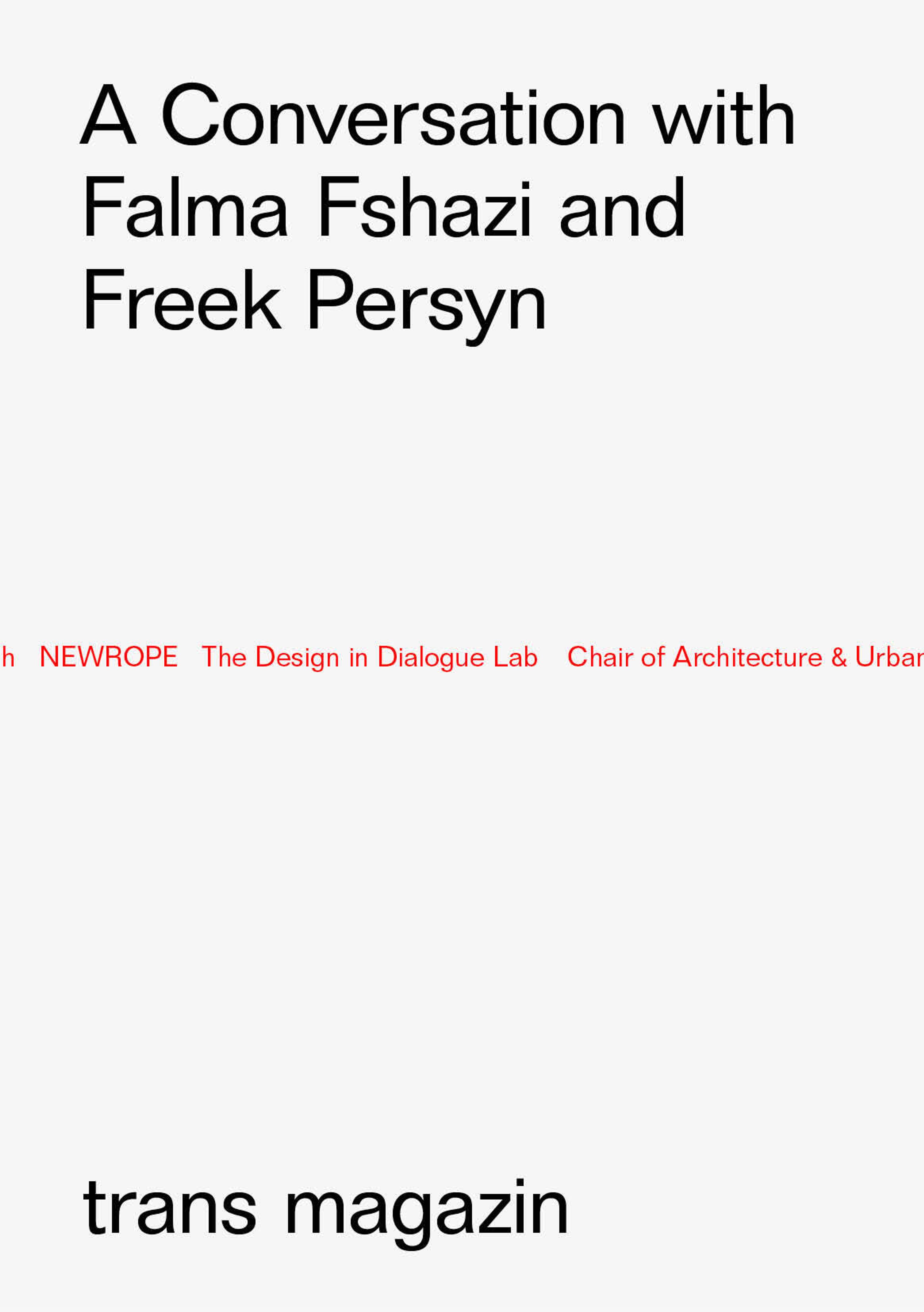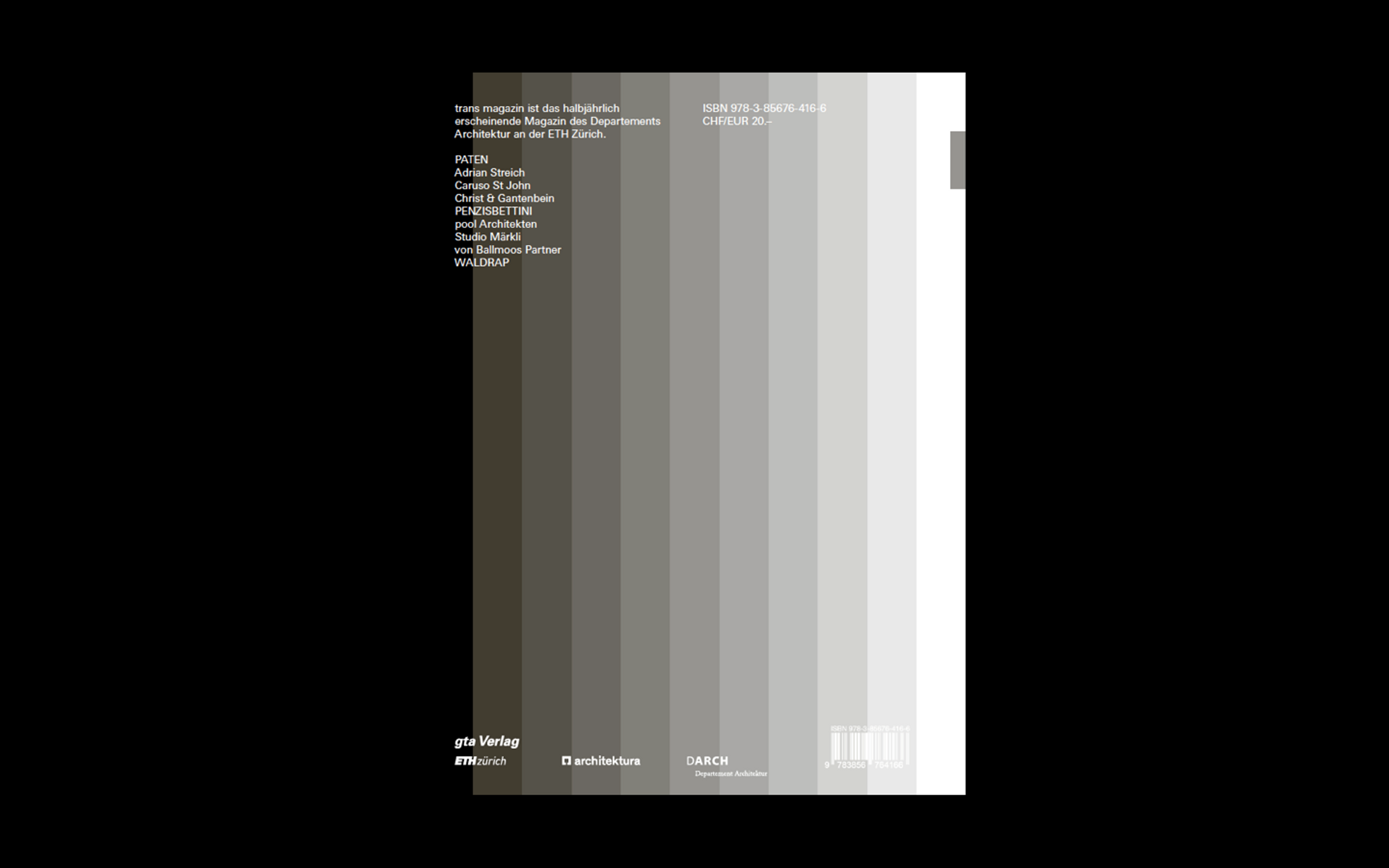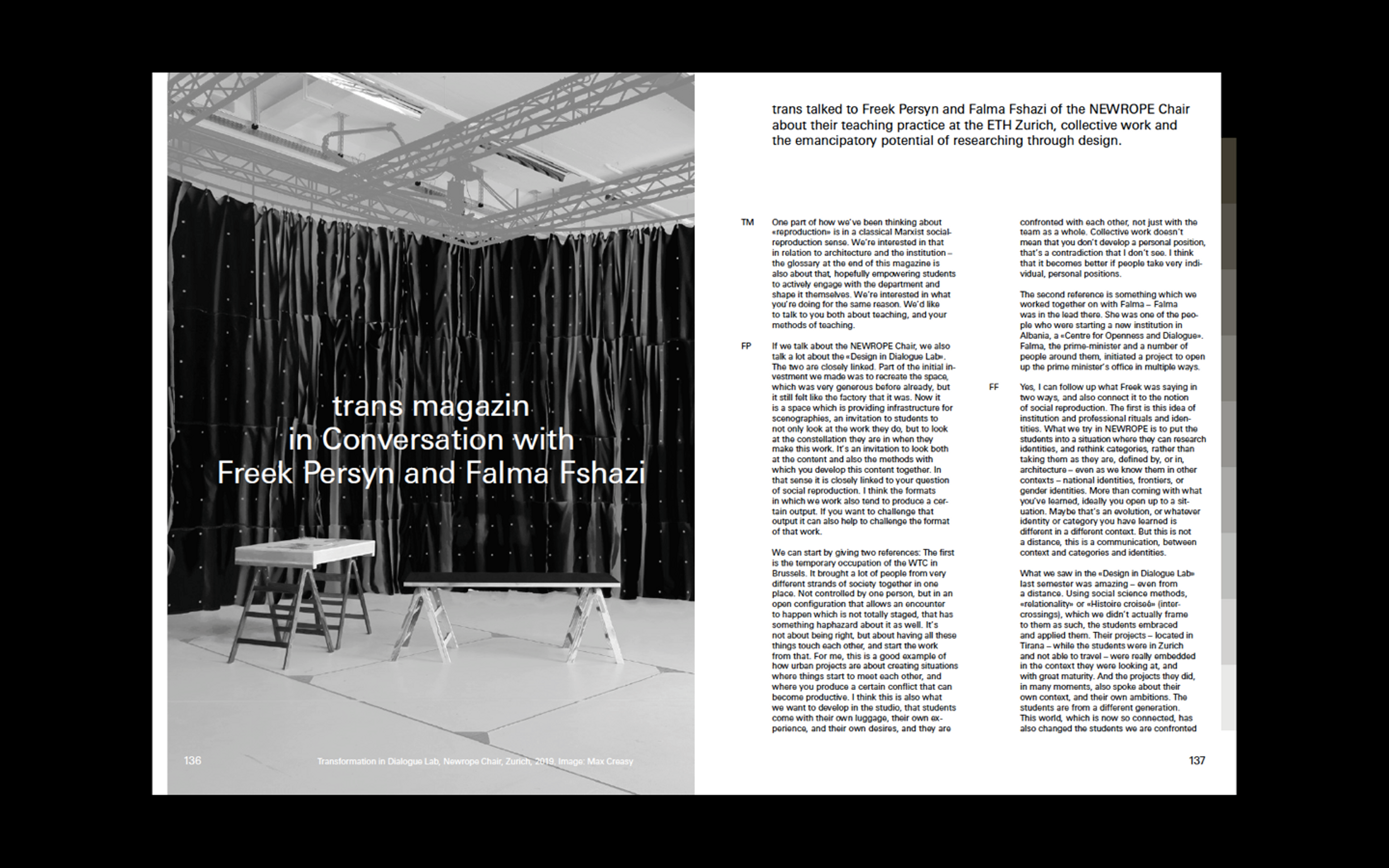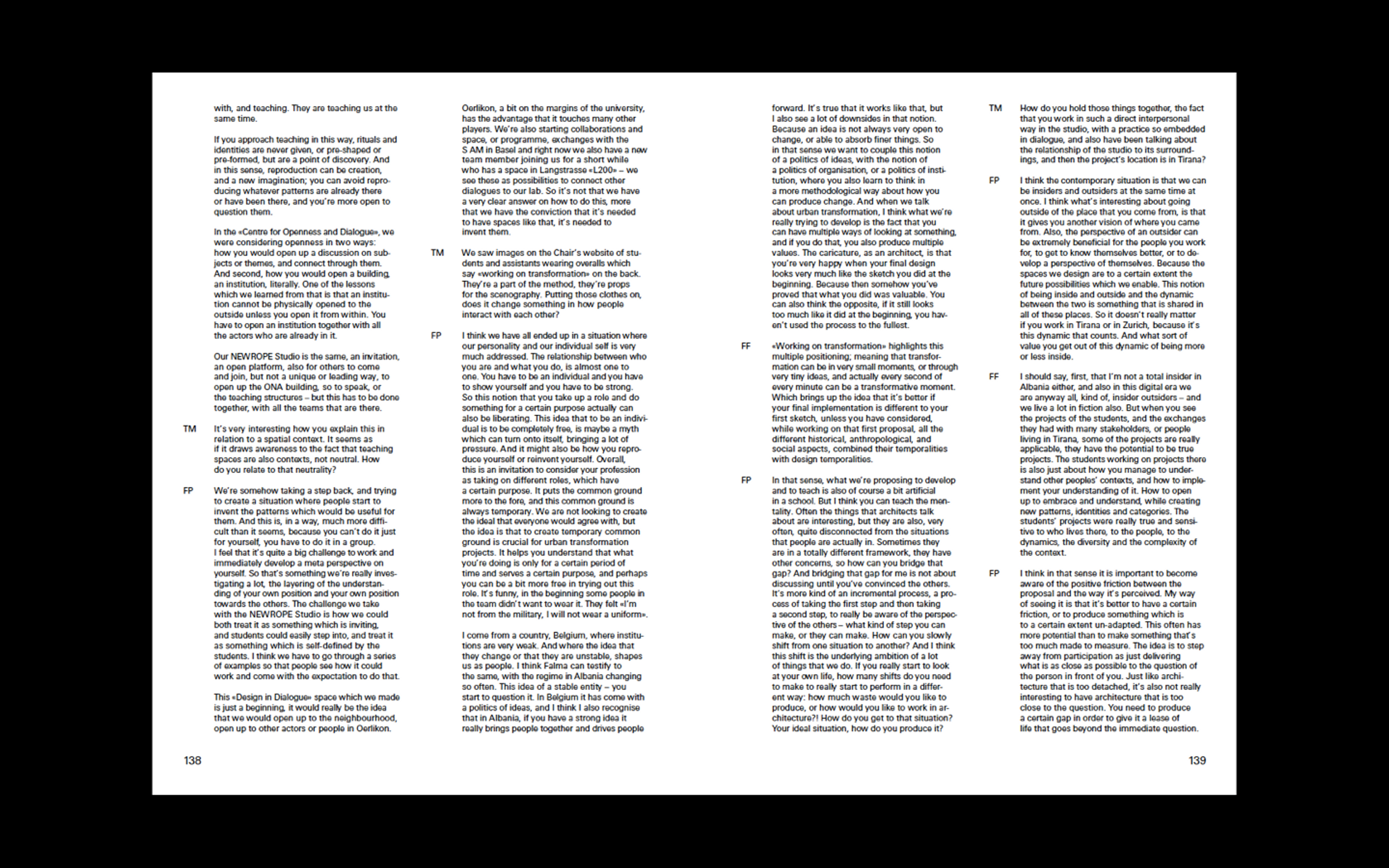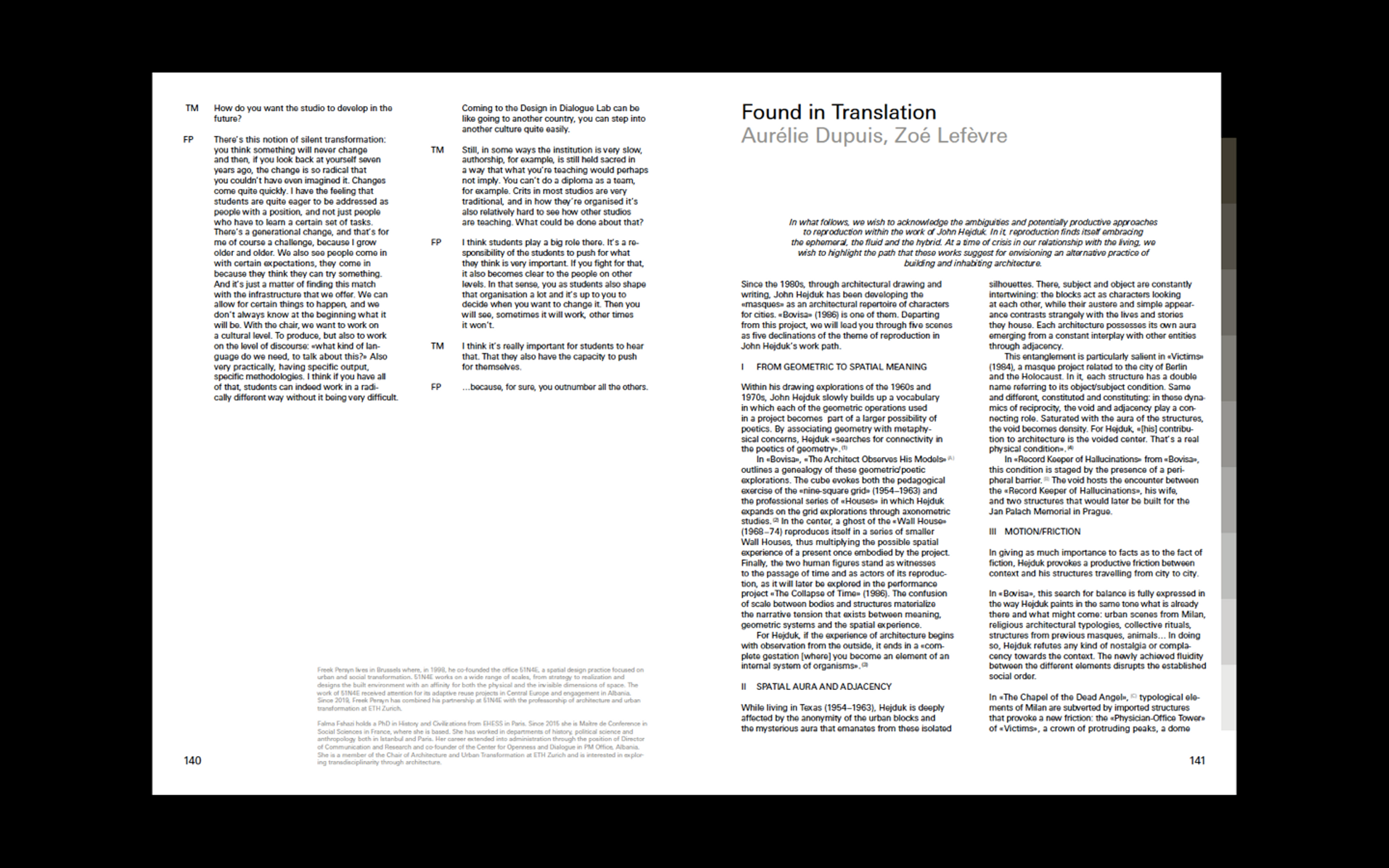Conversation with Falma Fshazi and Freek Persyn
trans magazin is a semi-annual professional journal of the Department of Architecture at ETH Zürich and has been managed by an independent student editorial team since 1997.
The title of trans magazin #38 is «Reproduction». In choosing this theme the editors were motivated by a number of topics, including Reproduction with respect to the (re)creation of social, institutional, professional identities.
For this issue trans talked to Freek Persyn and Falma Fshazi of the NEWROPE Chair about their teaching practice at the ETH Zurich, collective work and the emancipatory potential of researching through design.
Find the full interview at the bottom of this post.
trans magazine is available in selected bookstores or online via the bookshop of gta Verlag. The editorial team invites you to propose contributions for the upcoming issue trans#39 COMFORT. Fore more information please visit the website of trans magazin or send an email to trans@arch.ethz.ch.
Full interview
TM
One part of how we’ve been thinking about «reproduction» is in a classical Marxist social reproduction sense. We’re interested in that in relation to architecture and the institution – the glossary at the end of this magazine is also about that, hopefully empowering students to actively engage with the department and shape it themselves. We’re interested in what you’re doing for the same reason. We’d like to talk to you both about teaching, and your methods of teaching.
FP
If we talk about the NEWROPE Chair, we also talk a lot about the «Design in Dialogue Lab». The two are closely linked. Part of the initial investment we made was to recreate the space, which was very generous before already, but it still felt like the factory that it was. Now it is a space which is providing infrastructure for scenographies, an invitation to students to not only look at the work they do, but to look at the constellation they are in when they make this work. It’s an invitation to look both at the content and also the methods with which you develop this content together. In that sense it is closely linked to your question of social reproduction. I think the formats in which we work also tend to produce a certain output. If you want to challenge that output it can also help to challenge the format of that work.
We can start by giving two references: The first is the temporary occupation of the WTC in Brussels. It brought a lot of people from very different strands of society together in one place. Not controlled by one person, but in an open configuration that allows an encounter to happen which is not totally staged, that has something haphazard about it as well. It’s not about being right, but about having all these things touch each other, and start the work from that. For me, this is a good example of how urban projects are about creating situations where things start to meet each other, and where you produce a certain conflict that can become productive. I think this is also what we want to develop in the studio, that students come with their own luggage, their own experience, and their own desires, and they are confronted with each other, not just with the team as a whole. Collective work doesn’t mean that you don’t develop a personal position, that’s a contradiction that I don’t see. I think that it becomes better if people take very individual, personal positions.
The second reference is something which we worked together on with Falma – Falma was in the lead there. She was one of the people who were starting a new institution in Albania, a «Centre for Openness and Dialogue». Falma, the prime-minister and a number of people around them, initiated a project to open up the prime minister‘s office in multiple ways.
FF
Yes, I can follow up what Freek was saying in two ways, and also connect it to the notion of social reproduction. The first is this idea of institution and professional rituals and identities. What we try in NEWROPE is to put the students into a situation where they can research identities, and rethink categories, rather than taking them as they are, defined by, or in, architecture – even as we know them in other contexts – national identities, frontiers, or gender identities. More than coming with what you’ve learned, ideally you open up to a situation. Maybe that’s an evolution, or whatever identity or category you have learned is different in a different context. But this is not a distance, this is a communication, between context and categories and identities.
What we saw in the «Design in Dialogue Lab» last semester was amazing – even from a distance. Using social science methods, «relationality» or «Histoire croiseé» (intercrossings), which we didn’t actually frame to them as such, the students embraced and applied them. Their projects – located in Tirana – while the students were in Zurich and not able to travel – were really embedded in the context they were looking at, and with great maturity. And the projects they did, in many moments, also spoke about their own context, and their own ambitions. The students are from a different generation. This world, which is now so connected, has also changed the students we are confronted with, and teaching. They are teaching us at the same time.
If you approach teaching in this way, rituals and identities are never given, or pre-shaped or pre-formed, but are a point of discovery. And in this sense, reproduction can be creation, and a new imagination; you can avoid reproducing whatever patterns are already there or have been there, and you’re more open to question them.
In the «Centre for Openness and Dialogue», we were considering openness in two ways: how you would open up a discussion on subjects or themes, and connect through them. And second, how you would open a building, an institution, literally. One of the lessons which we learned from that is that an institution cannot be physically opened to the outside unless you open it from within. You have to open an institution together with all the actors who are already in it.
Our NEWROPE Studio is the same, an invitation, an open platform, also for others to come and join, but not a unique or leading way, to open up the ONA building, so to speak, or the teaching structures – but this has to be done together, with all the teams that are there.
TM
It’s very interesting how you explain this in relation to a spatial context. It seems as if it draws awareness to the fact that teaching spaces are also contexts, not neutral. How do you relate to that neutrality?
FP
We’re somehow taking a step back, and trying to create a situation where people start to invent the patterns which would be useful for them. And this is, in a way, much more difficult than it seems, because you can’t do it just for yourself, you have to do it in a group. I feel that it’s quite a big challenge to work and immediately develop a meta perspective on yourself. So that’s something we’re really investigating a lot, the layering of the understanding of your own position and your own position towards the others. The challenge we take with the NEWROPE Studio is how we could both treat it as something which is inviting, and students could easily step into, and treat it as something which is self-defined by the students. I think we have to go through a series of examples so that people see how it could work and come with the expectation to do that.
This «Design in Dialogue» space which we made is just a beginning, it would really be the idea that we would open up to the neighbourhood, open up to other actors or people in Oerlikon. Oerlikon, a bit on the margins of the university, has the advantage that it touches many other players. We’re also starting collaborations and space, or programme, exchanges with the S AM in Basel and right now we also have a new team member joining us for a short while who has a space in Langstrasse «L200» – we see these as possibilities to connect other dialogues to our lab. So it’s not that we have a very clear answer on how to do this, more that we have the conviction that it’s needed to have spaces like that, it’s needed to invent them.
TM
We saw images on the Chair’s website of students and assistants wearing overalls which say «working on transformation» on the back. They’re a part of the method, they’re props for the scenography. Putting those clothes on,does it change something in how people interact with each other?
FP
I think we have all ended up in a situation where our personality and our individual self is very much addressed. The relationship between who you are and what you do, is almost one to one. You have to be an individual and you have to show yourself and you have to be strong. So this notion that you take up a role and do something for a certain purpose actually can also be liberating. This idea that to be an individual is to be completely free, is maybe a myth which can turn onto itself, bringing a lot of pressure. And it might also be how you reproduce yourself or reinvent yourself. Overall, this is an invitation to consider your profession as taking on different roles, which have a certain purpose. It puts the common ground more to the fore, and this common ground is always temporary. We are not looking to create the ideal that everyone would agree with, but the idea is that to create temporary common ground is crucial for urban transformation projects. It helps you understand that what you’re doing is only for a certain period of time and serves a certain purpose, and perhaps you can be a bit more free in trying out this role. It’s funny, in the beginning some people in the team didn’t want to wear it. They felt «I’m not from the military, I will not wear a uniform».
I come from a country, Belgium, where institutions are very weak. And where the idea that they change or that they are unstable, shapes us as people. I think Falma can testify to the same, with the regime in Albania changing so often. This idea of a stable entity – you start to question it. In Belgium it has come with a politics of ideas, and I think I also recognise that in Albania, if you have a strong idea it really brings people together and drives people forward. It’s true that it works like that, but I also see a lot of downsides in that notion. Because an idea is not always very open to change, or able to absorb finer things. So in that sense we want to couple this notion of a politics of ideas, with the notion of a politics of organisation, or a politics of institution, where you also learn to think in a more methodological way about how you can produce change. And when we talk about urban transformation, I think what we’re really trying to develop is the fact that you can have multiple ways of looking at something, and if you do that, you also produce multiple values. The caricature, as an architect, is that you're very happy when your final design looks very much like the sketch you did at the beginning. Because then somehow you’ve proved that what you did was valuable. You can also think the opposite, if it still looks too much like it did at the beginning, you haven’t used the process to the fullest.
FF
«Working on transformation» highlights this multiple positioning; meaning that transformation can be in very small moments, or through very tiny ideas, and actually every second of every minute can be a transformative moment. Which brings up the idea that it’s better if your final implementation is different to your first sketch, unless you have considered, while working on that first proposal, all the different historical, anthropological, and social aspects, combined their temporalities with design temporalities.
FP
In that sense, what we’re proposing to develop and to teach is also of course a bit artificial in a school. But I think you can teach the mentality. Often the things that architects talk about are interesting, but they are also, very often, quite disconnected from the situations that people are actually in. Sometimes they are in a totally different framework, they have other concerns, so how can you bridge that gap? And bridging that gap for me is not about discussing until you’ve convinced the others. It’s more kind of an incremental process, a process of taking the first step and then taking a second step, to really be aware of the perspective of the others – what kind of step you can make, or they can make. How can you slowly shift from one situation to another? And I think this shift is the underlying ambition of a lot of things that we do. If you really start to look at your own life, how many shifts do you need to make to really start to perform in a different way: how much waste would you like to produce, or how would you like to work in architecture?! How do you get to that situation? Your ideal situation, how do you produce it?
TM
How do you hold those things together, the fact that you work in such a direct interpersonal way in the studio, with a practice so embedded in dialogue, and also have been talking about the relationship of the studio to its surroundings, and then the project’s location is in Tirana?
FP
I think the contemporary situation is that we can be insiders and outsiders at the same time at once. I think what’s interesting about going outside of the place that you come from, is that it gives you another vision of where you came from. Also, the perspective of an outsider can be extremely beneficial for the people you work for, to get to know themselves better, or to develop a perspective of themselves. Because the spaces we design are to a certain extent the future possibilities which we enable. This notion of being inside and outside and the dynamic between the two is something that is shared in all of these places. So it doesn’t really matter if you work in Tirana or in Zurich, because it’s this dynamic that counts. And what sort of value you get out of this dynamic of being more or less inside.
FF
I should say, first, that I’m not a total insider in Albania either, and also in this digital era we are anyway all, kind of, insider outsiders – and we live a lot in fiction also. But when you see the projects of the students, and the exchanges they had with many stakeholders, or people living in Tirana, some of the projects are really applicable, they have the potential to be true projects. The students working on projects there is also just about how you manage to understand other peoples’ contexts, and how to implement your understanding of it. How to open up to embrace and understand, while creating new patterns, identities and categories. The students’ projects were really true and sensitive to who lives there, to the people, to the dynamics, the diversity and the complexity of the context.
FP
I think in that sense it is important to become aware of the positive friction between the proposal and the way it’s perceived. My way of seeing it is that it’s better to have a certain friction, or to produce something which is to a certain extent un-adapted. This often has more potential than to make something that’s too much made to measure. The idea is to step away from participation as just delivering what is as close as possible to the question of the person in front of you. Just like architecture that is too detached, it’s also not really interesting to have architecture that is too close to the question. You need to produce a certain gap in order to give it a lease of life that goes beyond the immediate question.
TM
How do you want the studio to develop in the future?
FP
There’s this notion of silent transformation: you think something will never change and then, if you look back at yourself seven years ago, the change is so radical that you couldn’t have even imagined it. Changes come quite quickly. I have the feeling that students are quite eager to be addressed as people with a position, and not just people who have to learn a certain set of tasks. There’s a generational change, and that’s for me of course a challenge, because I grow older and older. We also see people come in with certain expectations, they come in because they think they can try something. And it’s just a matter of finding this match with the infrastructure that we offer. We can allow for certain things to happen, and we don’t always know at the beginning what it will be. With the chair, we want to work on a cultural level. To produce, but also to work on the level of discourse: «what kind of language do we need, to talk about this?» Also very practically, having specific output, specific methodologies. I think if you have all of that, students can indeed work in a radically different way without it being very difficult. Coming to the Design in Dialogue Lab can be like going to another country, you can step into another culture quite easily.
TM
Still, in some ways the institution is very slow, authorship, for example, is still held sacred in a way that what you’re teaching would perhaps not imply. You can’t do a diploma as a team, for example. Crits in most studios are very traditional, and in how they’re organised it’s also relatively hard to see how other studios are teaching. What could be done about that?
FP
I think students play a big role there. It’s a responsibility of the students to push for what they think is very important. If you fight for that, it also becomes clear to the people on other levels. In that sense, you as students also shape that organisation a lot and it’s up to you to decide when you want to change it. Then you will see, sometimes it will work, other times it won’t.
TM
I think it’s really important for students to hear that. That they also have the capacity to push for themselves.
FP
…because, for sure, you outnumber all the others.
INFO
– Published in trans magazin #38 Reproduction
– Authors: editorial team of trans magazin (Blanka Dominika Major, Ella Eßlinger, Jeremy Waterfield, Noé Giusi Lafranchi)
– With contributions by: Blerta Axhija, Jacqueline Badran, Francesco Battaini, Tatjana Lisa Blaser, Valerio Ciaccia, Linda Dannesboe Sjøqvist, Maarten Delbeke, Aurélie Dupuis, Gabriel Eggenschwyler, Sonja Flury, Falma Fshazi, Joshua Guiness, Lowis Gujer, Nina Guyot. Trajal Harrell, Michael Hoi Ming Du, Martina Hügli, Martin Jung, Beatriz Klettner Soler, Hannes Langguth, Zoé Lefevre, Felix Lehner, Felicia Liang, Emma Lindén, Nora Molari, Kim Nørgaard Helmersen, Sara Davin Omar, Amy Perkins, Freek Persyn, Emanuel Pulfer, Franceline Saby, Yann Salzmann, Benoit Seguin, Marco Veneri, Jakob Walter, Nicolas Wild, Yiran Zhang
– ISBN: 978-3-85676-416-6
– Price: CHF 20.00 / EUR 20.00
– Buy full issue here
